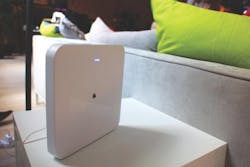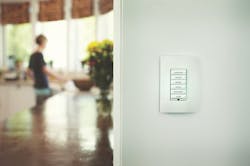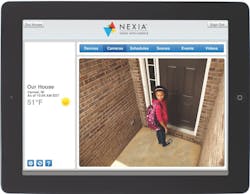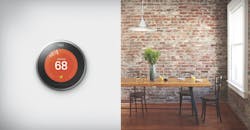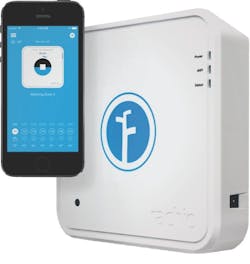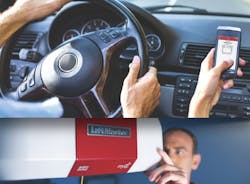Tech and business writers have become so fond of invoking The Jetsons as the poster family for smart homes that it’s now a cliché. Here’s the rub: Though there’s a lot about the future that The Jetsons got right—push-button mindset, a craving for automation, and even the revival of Googie architectural style—the cartoon’s creators were off by a good half a century. The sorts of advances imagined for 2062, the year to which we would have to time-travel to meet our space-age family, have already arrived and are up and running. A text sent by the security system that the kids are home from school, a reminder from the fridge that it’s time to buy more milk, a robot that takes family party pictures: These automation features are part of the here and now.
A wealth of options, now mainstream
A home that enables devices and systems to talk to one another via Wi-Fi and other protocols and to the outside world over the Internet was once a high-end option. Homes could be monitored whether owners were on-site or on the other side of the globe. Such capabilities used to cost five or six figures and demanded a specialized integrator. (Some still do.) But smart home technology is getting cheaper every day, and it’s designed to work with thousands of systems and appliances that you’re probably already specifying.
Recent nationwide market research has found that nearly 20 percent of homeowners now use at least one automated feature in their homes and that almost 60 percent would be interested in having a connected home.
“For builders, it’s a huge opportunity to differentiate from their competitors,” says Isabell Kerins, head of Design Lens, an arm of John Burns Real Estate Consulting. Builders such as Lennar, Meritage, Shea, and Toll Brothers have jumped in with both feet (Toll has been offering home automation for the last seven years through its subsidiary, Westminster Security). By the year 2020, it’s estimated that home automation will be a $1.7 trillion market, say both Business Insider and Forbes.
Wink
Security and climate control companies are embracing smart homes, too; others started up with the mission of delivering smart homes. Nexia, a subsidiary of Ingersoll Rand, offers a cloud-based software platform enabling a connected home. Nest Labs does it via security cameras, thermostats, or smoke detectors that link to one another; options are flexible. Wink, whose products are sold at websites such as Build.com, can connect lights, thermostats, and garage doors. Savant Systems connects the whole home, too, with a user interface lauded by custom builders for its simplicity and elegance. Control4, which has supplied scalable automation to smart homes for more than a decade, offers a basic package that runs about $1,500 that a customer can build off of as his or her needs grow.
The focus is changing to plug-and-play. Capabilities can be added piecemeal, as the homeowner likes, and even by homeowners themselves. The emphasis is on everyday features, not gee-whiz gadgets that make the party lights go on, says Gene LaNois, head of Nest Labs’ professional channel. “It’s about the things that help save energy and create comfort and awareness around the home,” he adds.
Confused? Here’s why
Sorting through a raft of increasing options can be confusing for both builder and buyer. “Home building is a features-based marketplace,” explains Emily Frager, chief marketing officer for Lennar Ventures, the home builder’s research and development division. Frager observes that retail has created a bits-and-pieces market, rather than bundling comprehensive offerings for smart homes. “Because retail hasn’t been the curator and hasn’t created a holistic after-market product, the consumer is left wanting something in their home that they don’t always get, unless there’s a dedicated tech person—and that’s the 1 percent of the 1 percent,” Frager says.
Another hurdle is the belief that whole-home automation costs a fortune. “What’s interesting to me is that there’s a sentiment in the market that home automation is ridiculously expensive,” says Darrell Scogins, CEO and co-founder of Double Rock Homes, a builder and developer in the Dallas-Fort Worth metroplex. “Look at flat-screen TVs—they used to be $5,000 or $6,000 and now they’re $500 or $600,” he says. “The same holds true for home automation. What used to be a $10,000 solution is now a $2,000 solution.”
Automation companies that want your attention also know they need to make life easy. “We don’t want the builders to have to become experts in technology,” says Nexia’s Steve Herbert, who handles business development for new construction nationwide. “We want to take that off your plate.”
The smart home as differentiator
The publics aren’t the only ones embracing smart homes. Small builders are, too. “We made a conscious decision to put home automation in every single house we built,” says Scogins, who’s set to build between 50 and 100 homes a year. He’s convinced that home automation makes for a better product (“a Mercedes-Benz versus a Ford Taurus”), and has long thought that remote control of the home will be in increasing demand. “I run my business this way,” he says. “Why can’t my customers do it with their homes?” Finally, Scogins points out that offering smart homes as standard differentiates him in a competitive marketplace.
Differentiation and competitive advantage are the keys here. Unlike marble backsplashes, spa-style bath fixtures, optional flex rooms, or appliance upgrades, smart home capabilities won’t bring profit margins, at least for the time being. “The technology is too young and price sensitive to rely on margin calls,” says CR Herro, vice president of environmental affairs for Meritage Homes. And smart home technology changes much more quickly than do countertop finishes and swimming pools, points out Blair Sonnen, public relations manager at Control4, who stresses that builders need to develop a team of professionals.
“The entry-level package that we’re putting in every home is under $2,000, including labor,” Scogins says. “Maybe I’m making $2,000 less in profit, but our houses are better, will sell faster, and we get a reputation for offering good value.” Double Rock’s standard package includes HVAC control, front and rear door locks, garage door openers, front and back door cameras, and interior motion sensors and lighting controls.
On competitive edge, Herro goes even further. Smart home technology, he says, “allows a home to take a different position than just being an inanimate object—it creates an emotional relationship. Before you had a door lock. Now you know that your kids are home safe when you’re not there. The promise is the personalization.”
Hank Belcher, vice president of sales and marketing at Newcastle Homes, which builds starter and middle-tier homes in Birmingham and Montgomery, Ala., says that not opting in means putting your company at risk. “We’re living in a world where people are expecting this,” Belcher says. “We’ve got to get caught up.” Belcher tried automation in his own home before he decided on Nexia (the company’s basic starter package includes a front door lock, thermostat with a hub, and timed lights for between $300 and $500), offering three levels of availability, depending on the price of the home. Standard in all Newcastle Homes is a hub, the device that controls the entire house, and a programmable thermostat. One and two levels up will get you automated lights, appliance modules, indoor and outdoor security cameras, and a garage door opener. As for Belcher’s favorite feature? “The motion-activated front door camera,” he says. “I know anytime anyone is at the front door even before they ring the bell. I pull up the video on my phone and see who it is.”
Ultimately, a smart home transcends convenience—peace of mind is what you’re selling, Herro says. “Once homeowners experience home automation, it’s very difficult to give up.”
Delivering a smart home
Learning curves and expectations differ among buyers. Here’s advice and insight from home builders with experience in home tech.
Bryan Flamm, Candlelight Homes
“The smart home can’t be fully functional until the router is up and running. That timing works well for us. Two weeks or so after move-in, a technician comes to the home to conduct an orientation and make sure everything is working.”
Emily Frager, Lennar Ventures
“Our timing is driven by solar. After the buyer has moved in and the shock of ownership has worn off, solar will get set up, and that’s when the consumer has the mind space and appetite to digest the features.”
Darrell Scogins, Double Rock Homes
“The young couple picked up their phones and got it within five minutes. The middle-aged couple took a bit longer to ramp up, but they loved it. It was a little more overwhelming for an older couple we sold to, but after working with them a few times and holding their hands, they picked up the basics—it just took longer to get them there.”
Felicia Ratka, Westminster Security/Toll Brothers
“Technology changes quickly, so we need to make sure we’re educating buyers on what type of network is required to support reliable solutions. It’s not uncommon for buyers to see commercials and think that the DIY systems that can be bought off the shelf are one-size-fits-all and then find out that this isn’t the case.”
The whole wired world
If the Internet is down, a smart home will still function because devices within are connected via wireless protocol, such as Z-Wave, Thread, ZigBee, or Wi-Fi. Checking in from the outside, however, requires Internet service. The world is getting more wired every day and service needs to keep up. “If you’re a builder of new homes, bandwidth is going to be an incredibly important buying decision for younger generations,” says Gene LaNois, who handles Nest Labs’ professional channel and stresses the crucial role that fiber optics will play. Randall Lewis, a principal at The Lewis Group, which develops MPCs throughout California and Nevada, agrees. “It’s not just Millennials and gamers,” he says. “Super high-speed Internet access is extremely valuable to a growing segment of buyers and renters. For some, it’s the deciding factor of whether they’ll even look at a community.”
Offering sustainability
Being able to control temperature and lighting from afar can translate to savings, and that’s something that homeowners would pay four figures for, Kerins says. “I’m an energy efficiency guy,” says Herro, who travels a lot. “When I’m sitting in the Dallas airport and know I’ll be home in Phoenix in three hours, I don’t have to sacrifice comfort and I don’t have to waste energy.”
Builders such as Shea, with SheaXero, its zero energy program, and Lennar, with its SunStreet solar subsidiary, also approach smart homes from a green position. With SunStreet, Lennar is bringing solar power to entry-level homes, a touchpoint that production building hasn’t had before, Frager says. “We know that 80 percent of homebuyers across demographics want smart home technology,” she says, adding that 75 percent of buyers consider solar to be smart home technology. “Today’s solar is so sophisticated that when you integrate it with a smart home system, you not only create your own power, you can regulate how it gets used.”
Saving water is an urgent concern in drought-stricken areas of the U.S. This, too, is in the realm of the smart home and has been made simple. Rachio, a Denver-based company, offers a $250 sprinkler controller that works with “most home automation systems out there,” says CEO Chris Klein, including Nest, Nexia, Control4, Crestron, Xfinity Home, Wink, Alarm.com, and Ifttt. “Depending on how someone was watering before, we estimate a 30 percent average in water savings,” Klein says. Like others we spoke with, Klein stresses flexibility in the range of what’s possible for buyers interested in a smart home. “Do they want a whole-home solution right off the bat, or to test the waters?” he asks. “We’re looking to be in both stories, to offer the best of both worlds.”
Safety, security, and the grandkids’ attention
Knowing that your kids got home safely and checking to see if it’s the UPS delivery person at the front door or the lawn guy in the backyard are selling points. But Kerins says that some of the most enthusiastic consumers of smart homes are the growing number of Americans aged 55 and older, who want to age in place, complete with motion-activated lights that go on when someone enters a room and go off after a minute or two if someone leaves and forgets to flick the switch. If there’s lack of movement in a home by a certain time of day, a motion detector can be programmed to prompt a phone call or text message to be sent to a loved one so they can check in.
Shea Homes offers smart home technology as standard at Rio Vista, a 55-plus community east of San Francisco. Included are a front door lock, lighting controls for the kitchen, great room, and exterior, and a thermostat. A garage door opener, cameras, and motion sensors can be added. A smart home, it turns out, is a nifty way for grandparents to connect with kids and grandkids by staying up to date and tech savvy. “That’s where we hit it,” says Jason Enos, a general manager at Shea. In a sophisticated, tech-centric market that’s highly competitive, “We’re converting at two to three times the competition,” Enos says. In an industry that has long been accused of being short on innovation, he adds, “This is the next boom.”
Providing convenience
“We went all in two years ago and all of our homes, from entry-level townhome to higher end, all include technology as standard,” says Bryan Flamm, managing partner of Candlelight Homes in South Jordan, Utah. Candlelight serves a tech-savvy market; digital natives are its target. Yet Flamm is aware that not every potential buyer may care about technology enough to make it the deciding factor in a home purchase. “There are still some people who think they’re not going to use it,” he says. “But our surveys show that they’re using it and liking it, even if they didn’t initially come to us because they wanted a smart home.” Like other builders, Flamm cites the phenomenon of the smartphone, a device that few of us imagined we’d rely upon to run our lives. As for Flamm’s favorite feature, it’s the garage door control, by LiftMaster, which he operates from his phone. “I can’t tell you how many times I’ve been lying in bed at night and my wife asks me if I closed the garage door,” he says.
Getting into smart homes may involve taking the bull by the horns. Flamm reports that an initial challenge was the many suppliers he talked to who came from the security industry, had only done smart homes on a custom level, and were accustomed to working on bigger margins. “They weren’t used to getting in and getting out, everything set for them, and making money on volume,” he says. Convinced that the technology didn’t have to have a high price tag, Candlelight “partnered with a couple of up-and-coming installers, grooming them to do production, and showing them how to make money,” Flamm says. Candlelight now works with Control4, which is based in Salt Lake City, and its being local is a draw for target buyers.
Most builders we talked with use smart technology in their own homes; Frager is one of the few we spoke to who doesn’t—yet. “I’m in a wait-and-see mode,” she says. “Consumers want the technology, but everyone is in this space right now, and I want to see who shakes out as the winners and the losers.”
Enhancing lifestyle, too
It may be bells and whistles for some, but for others being able to program rooms is part and parcel of a smart home. Savant Systems enables homeowners to make changes themselves. They can set actual scenes, programming and saving lighting and window-shade positions, sound and video, heating and cooling. “We think about the experience in the home,” says Tim McInerney, director of product marketing for Savant, who says that this includes a homeowner not having to think about complexity and programming.
“My personal opinion is that you should separate audio-visual from home automation, for simplicity’s sake,” Belcher says. “Home automation and home entertainment are entirely different things. You can integrate them, but you don’t need to, and systems get more expensive when you do.”
What about hackers?
It’s hard to go a week without hearing news of serious hacking incidents. We quizzed builders and suppliers alike about security. They acknowledge that while it’s an important concern, being hacked isn’t at the top of homebuyers’ minds. Some were surprised by this, others not. Still, “Third-party experts test our system for vulnerabilities,” says Nexia’s Steve Herbert. Because Nexia is cloud-based, the company can automatically download upgrades into every user’s system. Herbert points out that security camera outputs are encrypted from the moment they leave the camera: “Even our technical support can’t see the video footage from subscribers’ cameras.”
“It’s the same as physical security,” says McInerney, giving the usual advice about using strong passwords and ensuring that devices have strong encryption technology. “A determined attacker who’s focused on getting into your home will be able to do it.” PB

